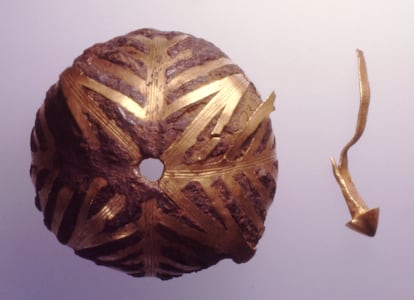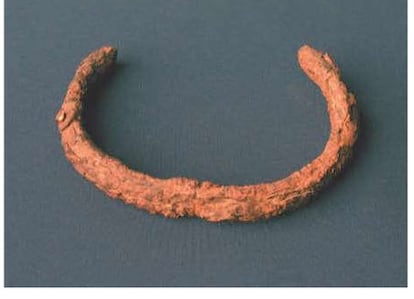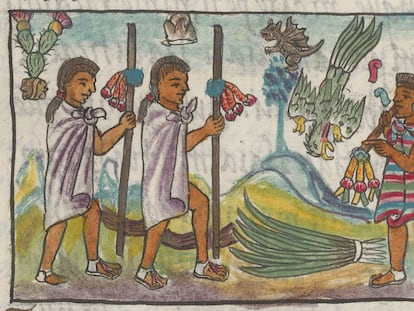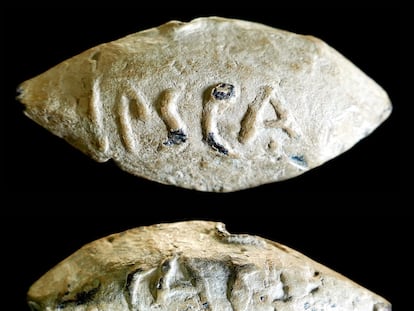The 3,000-year-old Treasure of Villena contains two pieces made with iron from ‘beyond planet Earth’
Made up of 59 objects found in 1965, the hoard has been dated to the Bronze Age and is the only one on the Iberian Peninsula made with material from a meteorite


The Treasure of Villena is one of the most important finds of gold articles dating from the Bronze Age (2,200 to 750 B.C.) in the Iberian Peninsula. It is composed of 59 gold objects (including 27 bracelets and 11 bowls) and a few pieces made of silver or iron. It was identified in 1963 by archaeologist José María Soler García after workers found various loose pieces in a gravel pit in Villena (eastern Spain). The discovery ignited an enormous scientific debate because it has no relationship with any of the archaeological sites in its surroundings, with the sole exception of what is known as the Cabezo Redondo hoard (35 objects), found in 1963 also in Villena, and which includes some similar golden pieces.
The Treasure of Villena is kept in an armored display case, given its immense value, in the town’s archaeological museum. Experts have always doubted whether it belonged to the post-Argaric period (1,500-1,300 B.C.) or the last stages of the Late Bronze Age (8th century B.C.). Now, the study Meteoritic iron in the Villena Treasure? by researchers Salvador Rovira-Llorens, Martina Renzi ,and Ignacio Montero-Ruiz, from the National Archaeological Museum, the Diriyah Gate Development Authority (Saudi Arabia), and the Institute of History at the Spanish National Research Council (CSIC) respectively, has added a spectacular fact thanks to metal analysis carried out on some of the pieces: they were made in the Late Bronze Age (1,400-1,200 B.C.) using iron from a meteorite.
The key that leads some researchers to place the chronology of the complex well into the Late Bronze Age and Early Iron Age is the existence of two iron pieces: a small hollow semisphere covered with a sheet of gold, supposedly interpreted as a pommel of a sword hilt, and an open bracelet. “They are the first objects found in the Iberian Peninsula that were made with material from beyond planet Earth,” the experts say.
The pommel is decorated with three bands, crossed by four parallel strips that create four sectors and result in a four-pointed star. The bracelet is an open ring, with rounded and somewhat flattened ends. Its discoverer described it as “a dark leaden metal. It is shiny in some areas, and covered with a ferrous-looking oxide that is mostly cracked.”

Their analysis has been able to determine that these are not pieces made with terrestrial iron produced by the reduction of minerals existing in the mantle of planet Earth. Instead, they are “extraterrestrial and [were] made during the Late Bronze Age.” To obtain this data, two tiny extractions were made, under the supervision of the technical staff of the Alicante museum. The samples were then taken to Madrid for analysis at the laboratory of the National Archaeological Museum.
“Meteorite iron is found in certain types of aerolites that, since they come from outer space, are composed of an iron-nickel alloy with a variable nickel composition greater than 5% by weight. They also contain other minor and trace chemical elements, cobalt being one of the most significant. However, the levels of nickel in terrestrial iron are generally low or very low and frequently not detectable in analysis,” the study explains.

Iron is a material that oxidizes in the short term in the presence of oxygen and water, forming oxides and hydroxides, which gives it its characteristic brown rust. “Meteorite iron is no stranger to this phenomenon, so most of the objects made with it are in a very delicate state of conservation,” the authors of the study point out.
Tutankhamun's Tomb
But every rule has its exception, and in this case it is found in one of the objects from Tutankhamun’s tomb, in particular a recently reanalyzed dagger with a gold handle. Its blade barely shows signs of oxidation due to the extreme dryness, which could have favored its conservation in excellent condition. However, other iron objects (16 miniature chisels) from the same tomb showed distortions on their surface.
The first analyses on the pommel and bracelet at the National Archaeological Museum “clearly indicated the presence of iron and nickel, with very high peaks of the latter. The cobalt peak was more doubtful.” Therefore, the test was repeated, using the mass spectrometry technique, at the Curt-Engelhorn-Zentrum Archäometrie (CEZA, in Mannheim, Germany). This technology is more sensitive than that used in Madrid and resulted in “the pommel being possibly made of meteoritic iron, with a nickel proportion of 5.5%.” The bracelet, on the other hand, only had 2.8%, “too little to be meteoritic iron.” For this reason, technicians Ernst Pernicka and Michael Brauns, from the German laboratory, suggest new analyses.
In any case, the conclusions obtained in Spain and Germany are clear: “The results of the analyses carried out on the iron pieces from the Villena hoard indicate with a high probability that they are objects made with meteoritic iron.” And they explain: “The available data suggests that the pommel and bracelet from the Villena hoard would currently be the first two pieces attributable to meteoritic iron in the Iberian Peninsula. This is compatible with a chronology of the Late Bronze Age [1,400-1,200 B.C.], prior to the beginning of widespread production using terrestrial iron. The chronology of abandonment of Cabezo Redondo [the other hoard related to that of Villena] dates back to before 1,200 B.C., and the relationships established between the two seem to be the best arguments to establish the chronology.”
Ignacio Montero Ruiz, from the CSIC Institute of History and one of the experts who contributed to the report, concludes: “These two pieces of iron had enormous value. For this reason, they were considered worthy of becoming part of this spectacular ensemble with numerous delicate gold objects and ones made with a very special iron. Who manufactured them and where this material was obtained are still questions that remain to be answered.”
Sign up for our weekly newsletter to get more English-language news coverage from EL PAÍS USA Edition
Tu suscripción se está usando en otro dispositivo
¿Quieres añadir otro usuario a tu suscripción?
Si continúas leyendo en este dispositivo, no se podrá leer en el otro.
FlechaTu suscripción se está usando en otro dispositivo y solo puedes acceder a EL PAÍS desde un dispositivo a la vez.
Si quieres compartir tu cuenta, cambia tu suscripción a la modalidad Premium, así podrás añadir otro usuario. Cada uno accederá con su propia cuenta de email, lo que os permitirá personalizar vuestra experiencia en EL PAÍS.
En el caso de no saber quién está usando tu cuenta, te recomendamos cambiar tu contraseña aquí.
Si decides continuar compartiendo tu cuenta, este mensaje se mostrará en tu dispositivo y en el de la otra persona que está usando tu cuenta de forma indefinida, afectando a tu experiencia de lectura. Puedes consultar aquí los términos y condiciones de la suscripción digital.









































